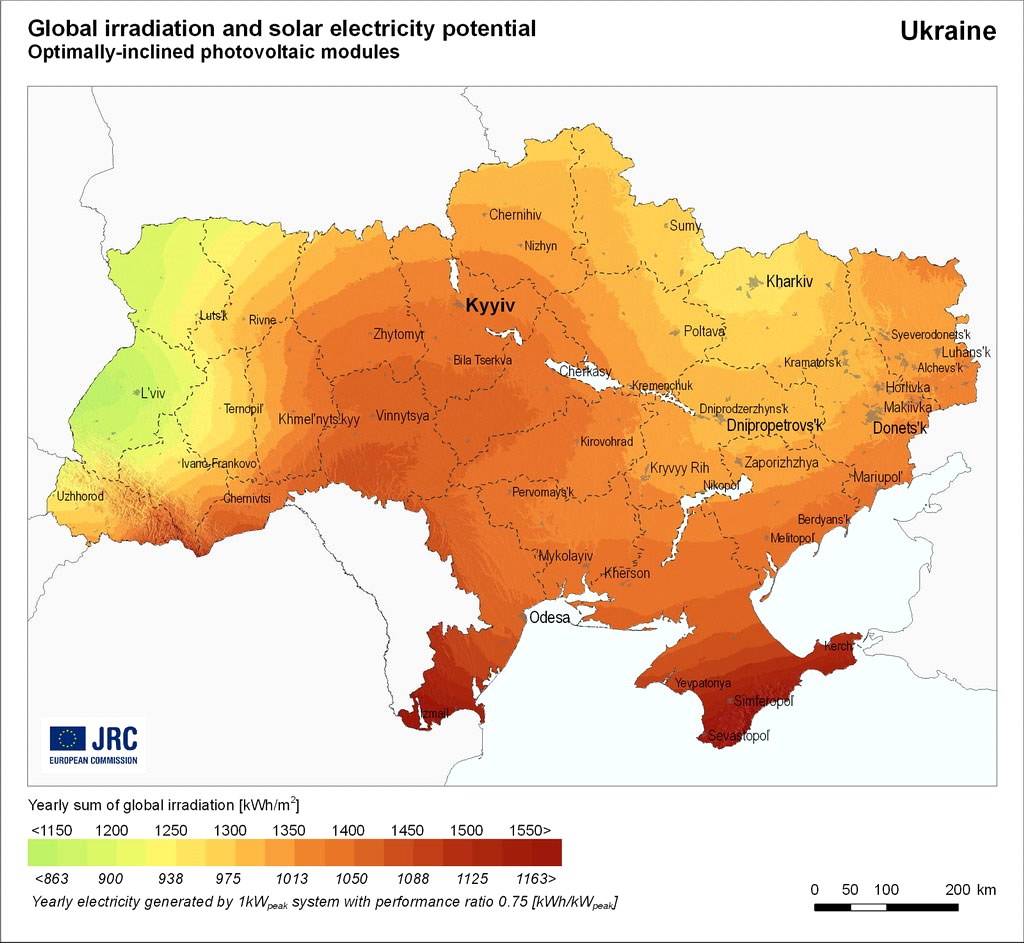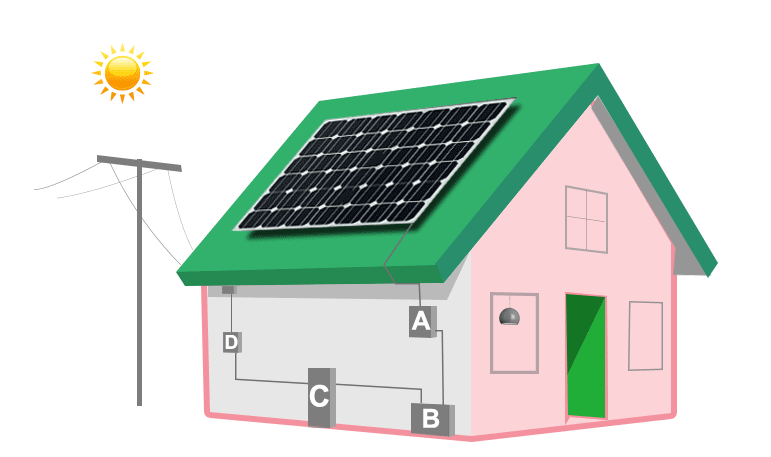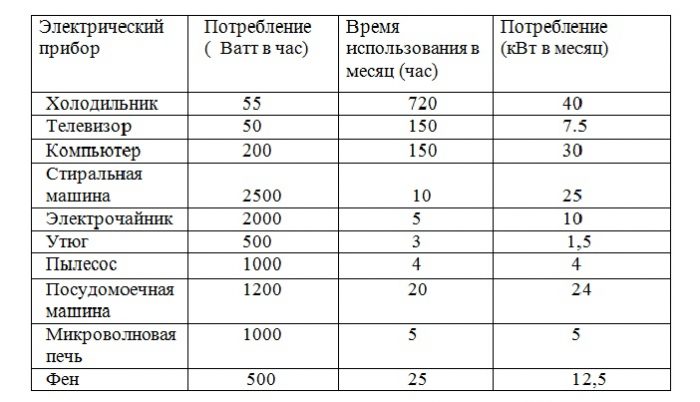Abstract
Содержание
- Introduction
- 1. Advantages and disadvantages of solar-powered residential buildings
- 2. Calculation of solar power
- 3. Solar Panel Installation Rules
- 4. Losses on batteries and inverter
- findings
- References
Introduction
Renewable energy sources (solar panels) are widely used as autonomous and backup power supply systems (SES) modern individual houses, cottages, other small consumers. Such systems allow the consumer to provide electricity, as in the complete absence of a centralized power supply system, and with temporary disruptions in the SES.
But the greatest interest are modernized systems that can not only fully perform the functions of backup and autonomous power supply, but also significantly reduce the consumption of electrical energy from the centralized SES. Maximum effect can be obtained subject to the creation of intellectual power management systems and a specially developed consumer connection to the network.
1. Advantages and disadvantages of solar-powered residential buildings
The advantages of residential buildings on solar energy are obvious:
- the sun’s energy is infinite (for at least the next 5 billion years, give or take)
- provides clean energy
- without greenhouse gas emissions and it can save people money on their electric bills
Disadvantages:
1. Service
Virtually the only thing a landlord should do is keep clean panels. This is an important task, because too much snow, dust and bird droppings on panels can reduce the amount of sunlight. The accumulation of dust on the screen can reduce the amount of electricity generated by the system. by as much as 7 percent.
2. Neighborhood
The location of your home has a big impact on your solar energy efficiency. This is an obvious problem: If your electrical power depends on sunlight, such things as the shadows of tall trees and the tall shadows of buildings will be a problem. This is a bigger problem than some people understand. Different types of panels react differently to the shadow. While polycrystalline panels allow significantly reduce the output of electricity, then any part of the shading of the mono-crystalline panel will stop the production of electricity completely. Thus, To build a solar–powered house, you need to make sure that there is no shade on the panel over the roof area during the sundial per day (usually, from 10 am to 2 hours) and preferably during all sundial hours. The more hours the panels are exposed to full sunlight, the more effective power generation. Achieving the most efficiency can mean pruning or complete removal of trees in your area. If your home is surrounded by tall buildings that blocking the sun from the roof, this is a much bigger problem.
3. Insolation
Sunlight obviously plays a key role when it comes to solar energy, and not all regions have equal conditions in this regard. It is important to know how much sunlight reaches the ground in the area where your potential solar home is located. What we are talking about here is called insolation - a measure of how much solar radiation will fall on the earth in a particular area in a certain period of time. This is usually measured in kilowatt / m 2 / day, and it will show you how much sunlight will be available for your solar panels to turn into electricity. The higher the insolation value in your area, the more electricity each of your panels can generate. A high insolation value means you can get more energy from smaller panels. A low insolation value means that you could end up spending more to achieve the same power output. So you have to build your house solar-powered in the south-west, and not in the north-west? Not at all. This simply means that you will probably need more panels to achieve the same power output.

Picture 1 – Insolation level kW / h / day
4. Coverage area
Only two parameters should be considered:
- insolation that we just discussed
- how much energy do you need
To get a very rough estimate of how big the system is, you need to look at your electric bill and find out how much you are using kWh per day. The average home uses about 900 kWh per month, or about 30 kWh per day. Multiply that by 0.25. We get 7.5, so we need 7.5 kW of system. A typical solar panel produces up to 120 watts, or 0.12 kW per day. To provide 7.5 kW, you need about 62 panels. One panel may be approximately 142 by 64 centimeters, so the 62 panels will occupy approximately 65 square meters. You should also consider insolation and how many hours of peak sunlight you get per day, and also make adjustments if you use rechargeable batteries. with panels. Therefore, it is best to turn to the profi.

Picture 2 – Panel layout example
(animation: 12 frames, ∞
repetition cycles, 90 kb)
5. Costs
For 7.5-kW or 7,500 watt panels, you could pay between $ 22,500 and $ 37,500. If you need less electricity, of course, the number becomes below. If you only consume 600 kWh per month, or 20kW / day, you could install a system with a capacity of up to 5 kW. Which will cost closer to $ 5,000. Of course, you can partially provide the house with solar energy. If you want to invest in solar $ 10,000, you can supplement electricity from mains with a 1.5-kW solar system. However, tens of thousands of dollars for solar panels are still quite exorbitant costs - especially since it may take decades until this money. repulse back. Although in the west they are already practicing renting solar panels. There are no down payments. Homeowners pay a monthly rent for the use of panels, and the rental company owns and supports them.
6. Recycling
The service life of solar panels 40-50 years, the controller and inverter 15-20 years, batteries, depending on the type and nature of use, 4-10 years. Although the issue of recycling solar panels remains open, only 30% of all manufacturers take them back for recycling. Nevertheless, the demand for waste solar panels is growing every year. Since mining of rare metals is becoming increasingly expensive and recycling panels will result in their reuse.
2. Calculation of solar power
Calculation of the solar battery must begin with the calculation of the need for electrical energy. This can be solved in two ways. You can analyze the meter readings, and you can calculate the amount of installed capacity of all consumers. This list includes:
- heating equipment;
- fridge;
- Washer;
- lighting, etc.
For convenience, we present a table of the average consumption of electricity in the house

Picture 3 – Table of average electricity consumption in the home
3. Solar Panel Installation Rules
Solar panels, installed in the yard or on the roof, are capable of producing energy only in the presence of light. Maximum (passport) they reach power with a cloudless sky and light on their surface at an angle of 90 degrees. At other corners produced energy is significantly reduced. Moreover, in cloudy weather, it can fall 15 to 20 times. All this is necessary to know, performing the calculation solar panels for a private house.

Picture 4 – Panel installation example
When calculating the number of solar batteries for a house, it makes sense to focus on working hours, it is during these hours that solar panels work at full capacity. In the morning and evening, the amount of energy produced will be from 20 to 30% of the installed capacity, and the rest will be generated during working hours.
The calculation of the power of solar panels for the home shows - a panel with a capacity of 1 kW on a summer day is guaranteed to produce 7 kW per day or 210 kW per month. You can, of course, add the amount that will be produced at twilight time of the day (morning and evening), but better consider it as a reserve in case of changing weather conditions. By the way, if the panels are installed in one place, then, of course, they will not generate all specified power rating. That is, if the landlord install panels total capacity at 2 kW, then per month it will generate approximately 420 kW of energy. Also, the number of kilowatts produced depends on the level of insolation in your region.
4. Losses on batteries and inverter
The required amount of energy in the dark should be enough to survive it. When consumed3 kWh, Batteries should store exactly this amount of energy. But, it is unacceptable to completely discharge them, for example, car batteries can be emptied by 50%. It is possible to calculate an approximate reserve of stored energy–with a daily consumption of 10 kWh, battery capacity should be equal to this figure.
Inverters, which are an integral part of the solar energy system, have an efficiency of 70 - 80%. Thus, it can be concluded that the use of the battery, inverter, controller, system will lose from 40 to 50% of the generated power. That is, the homeowner will have to increase the number of panels by these interest losses and this figure can change the calculation of the cost of solar batteries for a private house.
findings
It can be concluded that the use and introduction of such sources of electricity into the power supply system as a whole can be called effective, although and not entirely cost-effective event and if we consider the increase in consumption of natural resources such as natural gas, oil, coal that have a long renewal period, such decisions on the use of renewable energy sources (RES) is appropriate. Also, we should not forget that such energy sources will significantly reduce the release of harmful substances and toxins into the environment. Wednesday
When writing this essay master's work is not yet completed. Final Completion: May 2019. Full text of the work and materials on the topic can be obtained from the author or his manager after the specified date.
References
- Безруких П. П. Состояние и перспективы развития возобнов- ляемых источников энергии в России / П. П. Безруких, Д. С. Стребков //
- Справочник по ресурсам ВИЭ России и местным видам то- плива / П. П. Безруких [и др.] М.: ИАЦ Энергия, 2007.
- Климатические факторы возобновляемых источников энер- гии / В. В. Елистратов, Е. М. Акентьева, М. М. Борисенко, Н. В. Ко- бышева, Г. И. Сидоренко, В. В. Стадник. СПб.: Наука, 2010.
- Оценки ресурсов возобновляемых источников в России / Ю. С. Васильев, П. П. Безруких, В. В. Елистратов, Г. И. Сидоренко. СПб.: Изд.-во Политех. университета, 2009.
- Hau E. Wind Turbines / Munich. – 2008. 886 c.
- Магомедов А. Нетрадиционные возобновляемые источники энергии / Махачкала, 1996. – 245с.
- Chao Zhang, Matthias Meier, Wendi Zhang,.Influence of Interface Textures on Light Management in Thin-Film Silicon Solar Cells With Intermediate Reflector/ – М.: Наука, 2015. – 7 с.
- Хахалева Л. Нетрадиционные и возобновляемые источники энергии / Ульяновск, . – 2008. 33с.
- Eduardo F. Camacho, Tariq Samad, Mario Garcia–Sanz. Control for Renewable Energy and Smart Grids / From: The Impact of Control Technology, 2011. – 20 с.
- Зайцева М. Нетрадиционные возобновляемые источники энергии / Нижний Новгород, 2012. – 8 с.
